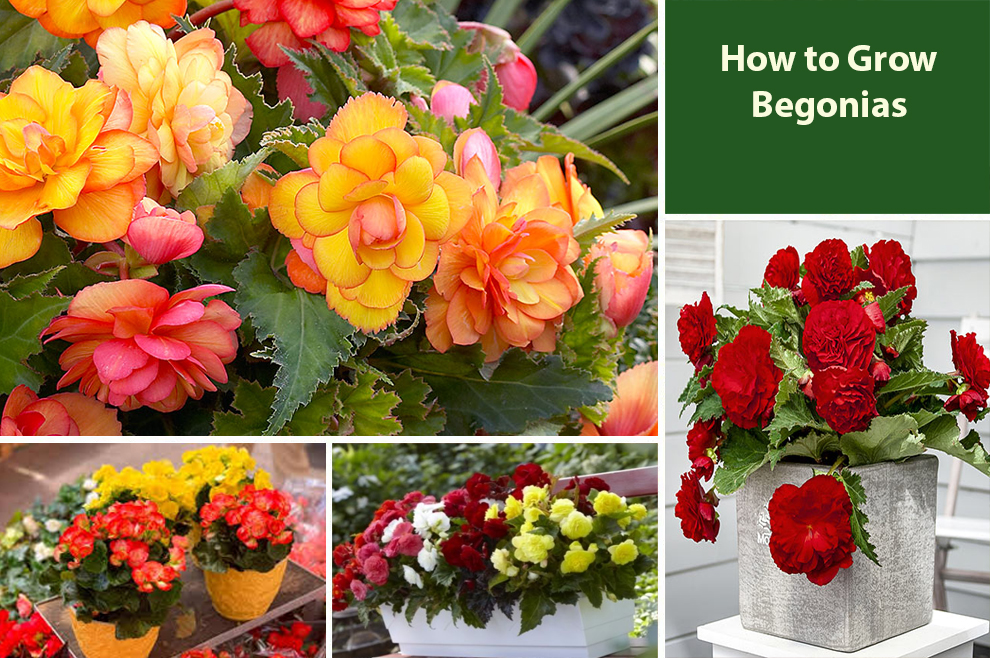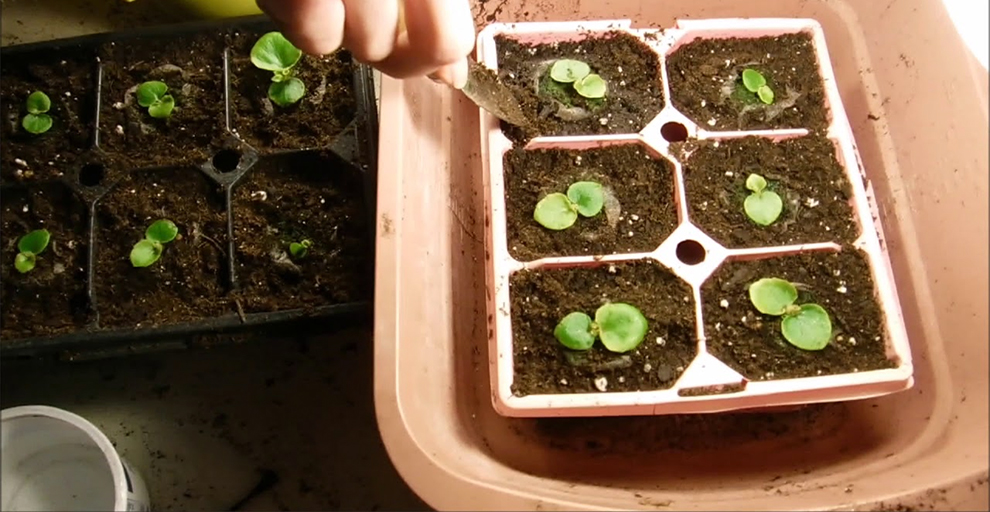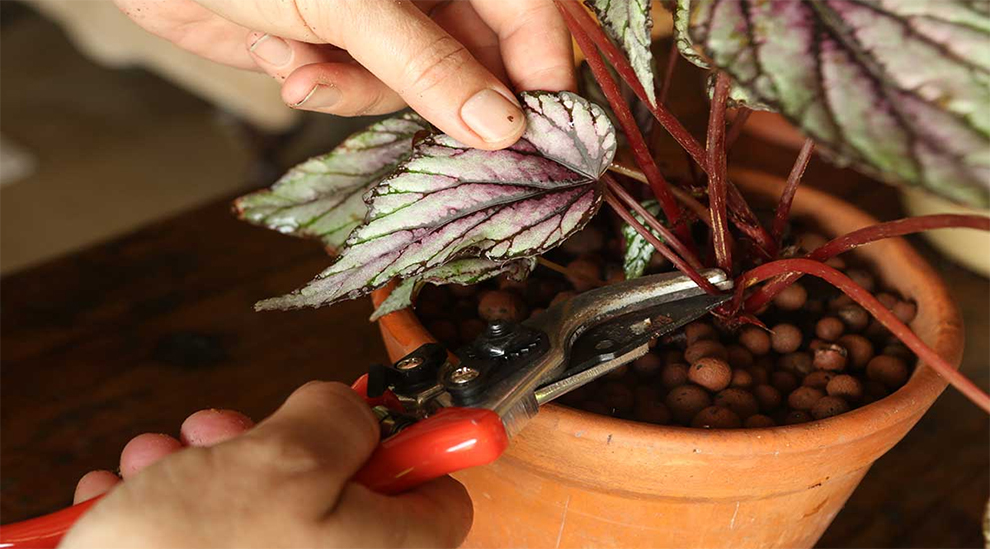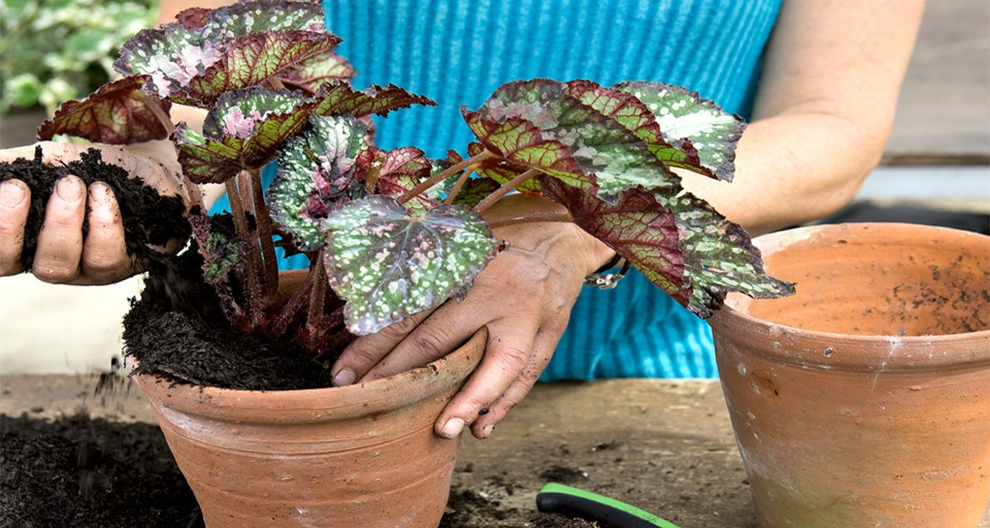How To Plant & Grow Begonias?
The most popular way to grow begonias is through bulbs. You must plant them in moist soil and in a location that receives indirect but ample light.

Begonias are known for their vibrant and showy flowers, making them popular for adding color to gardens, containers, and indoor spaces.
For all of you interested in learning ‘how to grow begonias,’ know that the process is not as complex as it may seem at first.
You can propagate begonias via stem cuttings, tubers commonly known as bulbs, or rhizomes. Only a few of the begonias produce seeds but they are unreliable for growing new plants.
For bulbous begonias, you must plant the bulbs in a well-drained soil mix with the rounded side facing upwards. Keep the soil moist and ensure it receives filtered sunlight.
Secondly, you can take the stem cuttings from mature plants, root in the soil mix, and transplant them into individual pots. Maintain a humid and warm temperature for successful growth. Partial shade, regular watering, and occasional feeding can help foster healthy begonia growth.
Though we don’t recommend it, but you may grow it through seeds. Sow the seeds in a well-drained soil mix and kept moist until germination. Once the seedlings show, give them partial shade and regular watering for continued growth.
How To Plant Begonia Bulbs, Seeds, and Stems?
Begonias are versatile and beautiful plants that can grow in different settings, including indoor spaces, pots, and gardens. They are a favorite of many gardeners with their attractive foliage and colorful blooms.
Regardless of the chosen propagation method, growing begonias will be a rewarding experience.
Let us explore the step-by-step guide on growing begonias:
Pick The Correct Begonias: Importance Of Choosing The Right Variety Of Begonia
Picking the correct begonia variety is imperative for successful growth, as it ensures the plant’s ability to thrive in your specific growing conditions and climate. Here are some reasons why it is vital to pick the apt begonia variety:
1. Climate suitability: Different begonias have specific climate preferences. Some are more heat tolerant, while others do best in cooler temperatures. Pick the variety well-suited to your climate to amplify the chances of your begonias thriving and generating a healthy yield.
2. Environmental adaptation: Some begonias are better suited to specific environmental conditions. Factors like soil type, sunlight exposure, and humidity vary for different regions. Thus, pick a variety that can adapt to your local environment. It will enable the plant to endure and flourish in its surroundings quickly.
3. Disease resistance: Different begonia varieties may have varying resistance to common plant diseases and pests. By picking a specie known for its disease resistance, you can lower the risk of begonia being affected by problems, leading to a more vigorous and healthier plant.
4. Aesthetic preferences: You can find begonias in different flower shapes, sizes, and colors. Thus, pick a kind that matches your aesthetic preferences. It lets you create a visual impact in your indoor space or garden, accentuating the overall appeal of the surroundings.
How To Plant Begonia Bulbs: Different Propagation Methods
You can propagate begonias via different methods, but the most prominent techniques are stem cuttings or bulbs.
Growing via bulbs involves planting them in a well-drained soil mix and keeping them moist until they sprout. If propagating via stem cuttings, always pick them from healthy plants. Both these methods demand proper care and attention for a successful yield.
A) How To Plant Begonia Tubers (Bulbs)?
Starting from the right timing to aftercare, here’s what you need to do.
When to plant begonia bulbs?
When planting begonia tubers, timing is crucial. You must ideally plant them in early spring once the danger of the last frost ceases and the soil warms up. It is usually between April and May, depending on your region.
Before planting begonia – prep the soil
Before planting, select a location that offers filtered light or partial shade, as begonias cherish indirect sunlight. Prepare the soil by loosening it and removing any debris or weeds. The soil must be rich in organic matter.
Planting the bulbs
Now, start with the below-listed process:
- Dig a hole large enough to accommodate the tuber with a depth of 2-3 inches.
- Place the tuber in the hole, ensuring the concave side faces up.
- Cover the tuber with soil, gently firming it around the base.
How many begonia tubers in a hanging basket should be planted?
If grown in hanging baskets, the number of tubers per basket depends on the basket’s size. In a standard 12-inch hanging basket, you can add two to three tubers. However, space them evenly, allowing for proper growth to avoid overcrowding.
Aftercare for the planted begonia bulbs
Once planted, water the tubers thoroughly to settle the soil. Maintain consistent moisture but do not overwater. As the tubers germinate and grow, ensure they receive regular care by fertilizing, watering, and guarding them against extreme weather conditions to ensure healthy begonia growth.
B. How To Grow Begonias From Seeds?

Growing begonias from seed is uncommon. But if you wish to do it, here is what to do:
1. Seed collection: Collect the mature begonia seeds from any existing begonia variety in your garden or yard.
Alternatively, you can shop for good-quality seeds from a reputable nursery online or offline. Ensure the seeds are fully developed and dry before you use them.
2. Sowing the seeds for germination: Take a seed pot or tray and fill it with a well-drained soil mix. Sprinkle the seeds on the surface and lightly press them into the soil.
Cover the pots or trays with a plastic dome or wrap them in a plastic bag to create a warm and moist environment for germination.
Move these seeds to a bright location, ensuring you do not expose them to direct sunlight.
3. Transplanting to a permanent location: After the seedlings show and develop a few sets of true leaves, you can transplant them to a prepared garden bed or individual pots.
Before transplanting, analyze the location. It must have well-drained soil (or you must have resourced to alter the soil, meeting your plant’s requirements) and receive filtered sunlight.
Remove the seedlings from the tray and transplant them, ensuring adequate space between the two plants.
4. Care and maintenance: Give them regular moisture to moisten the soil, without waterlogging it. Maintain a humid and warm environment, especially during the early growth stage.
Feed the seedlings a balanced plant food every few weeks to promote a healthy environment.
When the seedlings grow, acclimate them gradually to the environment outside before transplanting them to their ultimate garden location.
C. Propagating Begonias From Cuttings

Apart from learning how to grow begonias? Propagating begonias from cuttings is a popular and effective method. Here is how you can do it:
1. Selecting and prepping cuttings: Pick a healthy begonia plant with vigorous growth. Take stem cuttings about three to four inches long, especially from non-flowering stems. Remove any lower stems, leaving only a few leaves at the top.
2. Rooting the cuttings: Dip the cut ends of the stems in the rooting hormone powder to promote root development. Plant the cuttings in a well-drained soil mix or a container, having a perlite and peat moss blend.
Ensure the cuttings are inserted at a suitable depth, with the leaves just about the soil surface.
3. Creating a favorable atmosphere: Place the cuttings in a humid and warm environment away from direct sunlight. Cover them with a plastic bag or place them in a propagator to maintain high humidity. Mist the leaves regularly to keep them moist.
4. Root development and transplanting: After a few weeks, the cuttings will develop roots. Once the roots establish, typically in four to six weeks, you can transplant them into individual pots with well-drained soil.
Now gradually acclimate the new plants to their desired growing conditions, whether planted outdoors or indoors.
D. Dividing and Repotting Mature Begonias

Dividing and repotting mature begonias is crucial for promoting their health and avoiding overcrowding. Here is what you need to do:
1. Timing: The best time to divide and repot the mature begonias is in early spring when they begin showing signs of new growth. It lets the plants recover and establish well before the active growing season.
2. Prepare new pots and soil: Select the pots slightly larger than the current containers or pots. Ensure the new containers have drainage holes to avoid waterlogging. Prep a well-draining soil mix ideal for begonias, such as a combination of vermiculite, perlite, and peat moss.
3. Carefully remove the plant: Gently remove it from its current garden bed or pot. Tap the container or loosen the soil around the root ball for easy removal. Do it carefully to ensure you do not damage the roots.
4. Division: Examine the root system and identify the natural clusters or divisions. Use sharp, clean tools, such as a knife or shears, to separate the plant into individual sections. Each divided section must have a portion of the stem and a healthy root system.
5. Repotting: Place every divided section into a new pot filled with the prepared soil mix. Position the plant at the same depth as previously planted. Firm the soil gently around the roots, ensuring good contact.
Related: How to care for begonias outdoors? | Begonias lifespan
The Right Growing Conditions After Planting Begonias
You may use any of the methods mentioned above to grow begonias. But you will have to keep the below listed preferences of begonia flowers in mind.
A. Do Begonias Do Better In Pots or On The Ground?
Begonias can thrive in both ground and pots, but where you grow them depends on your preference.
To help you decide, know that potted begonias offer flexibility and mobility, allowing you to move them for winter protection or sunlight.
On the contrary, in-ground planting provides the plants with a more natural and stable growing environment.
Consider your specific circumstances, desired flexibility, and space available when deciding between ground or pot planting, and follow our above-stated begonias planting guide for the best results.
B. Do Begonias Like Sun or Shade?
Begonias prefer indirect or filtered sunlight. They thrive in well-lit, bright areas that get partial shade or morning sun across the day. Do not expose begonias to intense, direct sun for prolonged periods.
It can scorch the leaves and cause damage. But some begonia varieties, like tuberous begonias, can endure more sun. So check the specific requirements of your specie and then decide on the location.
C. Temperature and Humidity Considerations
Begonias prefer moderate temperatures between 60°F (15°C) and 75°F (24°C). They are sensitive to extreme cold or heat. Thus, adequate temperature control is crucial.
Begonias thrive in humid conditions, but good air circulation is needed to avoid fungal diseases. Maintaining a humidity of around 50-60% and avoiding temperature fluctuations will contribute to optimal growth.
D. What Is The Best Soil Mix For Begonias?
Begonias thrive in well-draining soil that retains moisture sans waterlogging. The ideal soil mix comprises vermiculite, perlite, and peat moss.
This mix ensures good drainage, aeration, and moisture retention, a favorable growing environment. Some gardeners also recommend adding compost or organic matter to enrich the soil and accentuate nutrient content.
E. How Often To Water Begonia?
Watering frequency depends on the soil type, pot size, and climate. Generally, you can water whenever the top soil inch feels dry.
Do not overwater, as begonias are susceptible to root rot. Hence, maintain a balance between regular watering sans letting the soil become waterlogged.
Alter the watering frequency based on your begonia’s specific needs and the prevailing environmental conditions.
F. What Is The Best Fertilizer For Begonias?
A water-soluble, balanced fertilizer with a 10-10-10 or a 20-20-20 ratio is best for most begonias. You can feed the plant every two to four weeks during the active growing season from spring to early fall.
Dilute the fertilizer as per the packaging instructions, and do not overfeed, as that can damage the plants. Using a controlled-release plant food at the start of the growing season can offer begonias slow-release nutrients over an extended period.
Remember to water the plants before and after fertilization to prevent root burn.
